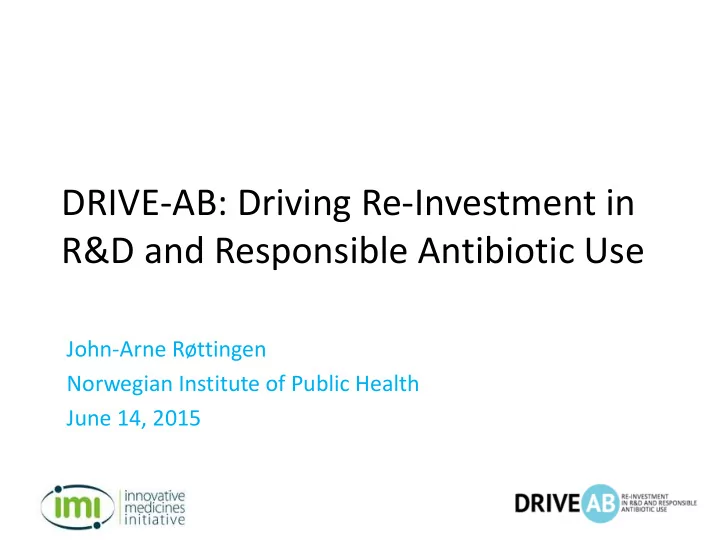

DRIVE-AB: Driving Re-Investment in R&D and Responsible Antibiotic Use John-Arne Røttingen Norwegian Institute of Public Health June 14, 2015
Once an antibiotic is introduced, resistance is not far behind…
But novel antibiotics are rare…
Antibiotic development- the status quo • Lack of incentives for pharma causes companies to close down their AB R&D departments • Reasons for the antibiotic market failure: – Science: AB R&D have become more complex and resource intensive – Economics: ABs have poor return on investments relative to other classes of drugs (e.g. drugs for chronic diseases) – Regulations : Pre/post market regulations deter AB development • Only three of top 50 pharma companies develop ABs Source: Spellberg B. (2011) http://www.tufts.edu/med/apua/news/news-newsletter-vol-30-no-1-2.shtml
The traditional pharmaceutical commercial model David J. Payne et al. Phil. Trans. R. Soc. B 2015;370:20140086
Application of traditional commercial model to antibacterials David J. Payne et al. Phil. Trans. R. Soc. B 2015;370:20140086
Commercial model does not incentivize future potential unmet needs David J. Payne et al. Phil. Trans. R. Soc. B 2015;370:20140086
Principles of a de-linked model David J. Payne et al. Phil. Trans. R. Soc. B 2015;370:20140086
R&D financing and incentive mechanisms Discovery Phase I Phase II Phase III Licensure Preclinical Delinkage / Push mechanisms Pull mechanisms • • Open knowledge innovation Advance Market E • X Milestone and end prizes Commitment (AMC) A • • PDP financing Debt / loans M • • Grants Equity / bonds P • • Subsidies Government-backed L • Tax breaks volume guarantees E S
DRIVE-AB objective To explore novel economic strategies and reward models both to promote the development of new antibiotics and to bolster appropriate consumption of existing antibiotics 3-year project (Oct 2014 – Sept 2017)
Work Packages • Define standards and metrics for responsible antibiotic use • Estimate the current and future impact of ABR on societies in order to determine future public health needs • Quantify the value of new antibiotics from the perspectives of patients, physicians, payers and society as a whole • Create, test and validate new economic models • Coordinate and manage the project • Stakeholder platform and external communication
Partners 16 public and 7 private partners from 12 countries • • British Society of Antimicrobial Astellas Chemotherapy • AstraZeneca • CEFAIA • Cubist • Chatham House • GlaxoSmithKline • London School of Economics • Pfizer • Norwegian Institute of Public Health • Roche • Radboud University Medical Center • Sanofi-Aventis • Tel-Aviv Sourasky Medical Center • University Hospital Rijeka • University of Antwerp And 50+ stakeholders • University of Geneva • University of Heidelberg • University of Lorraine • (1063.9 person months in University of Strathclyde • University of Tübingen total) • Uppsala University • Wageningen University
Objectives from today’s meeting To learn from you about: • Introducing novel antibiotics with limited clinical trial data • Considering resistance patterns and diversity of antibiotics in HTAs of novel antibiotics • Introducing novel antibiotics with non-inferiority trial design • How societal value and service fees (instead of unit prices) can be included in assessments
Questions? Thank you!
Antibiotics with limited clinical trial data – Example plazomicin • Achaogen developed a ph III pathogen-specific, randomized, open-label, active comparator controlled trial for plazomicin based on – pre-clinical data, – safety and tolerability from four ph I studies (n=143), and – similar efficacy to active comparator levofloxacin in a ph II study in cUTI (n=145). • Recently, Achaogen announced they will initiate a Phase 3 trial of plazomicin in complicated urinary tract infections
Resistance patterns and diversity of antibiotics in HTAs of novel antibiotics Antibiotic resistance varies widely across β -lactamase mediated countries and by agent Resistance Mechanisms A. P. ae baumanii AMR is responsible for 25,000 deaths in ESBL KPC Amp MBL OXA- C 48 the EU every year, with levels of resistance varying greatly between Ceftolozane/ countries. In Italy and Greece for Tazobactan instance, levels are higher overall when compared against the rest of Europe. Ceftazidime/ K. pneumoniae resistance K. pneumoniae resistance Avibactam to 3 rd gen. Cephalosporins, to Carbapenems, 2013 2013 Eravacycline MK7655 (Imipenem/ BLI) Carbavance (Meropenem/ BLI) < 1% 5% -10% 25% - 50% 1% - 5% 10% - 25% > 50% Most isolates are susceptible Most isolates are resistant Variable susceptibility Not affected by β -lactamases Source: EARS-NET (ECDC), BBC
Antibiotics with non-inferiority trial design Example - fidaxomicin
Antibiotics are invaluable, with a wide range of primary and secondary applications At least 5% of patients undergoing a surgical When penicillin was introduced, it changed the procedure develop a surgical site infection (NICE) fatality rate of 90% for patients with pneumococcal pneumonia and concomitant bloodstream infection to a survival rate of 90% (WHO) 90% 5% A post-antibiotic era means, in effect, an end to modern medicine as we know it. Margaret Chan, 10% 26% Director-General, WHO One out of every 10 cancer patients who receives Even with antibiotic treatment, the mortality rate for early-onset infection in low birth weight babies is up chemotherapy gets an infection that requires a hospital visit (CDC) to 26% (NICE) Sources: Antimicrobial resistance in the European Union and the world (WHO), Antimicrobial Resistance – Global Report on Surveillance (WHO), Prevention and Treatment of Surgical Site Infection (NICE), Cancer Prevention and Control (CDC), Antibiotics for Early-Onset Neonatal Infection (NICE) 18
Economic models Lump-sum model • A global body purchases the global sales rights to new antibiotics and manages their supply. • The development and manufacture of drugs would still take place within the pharmaceutical industry with stipulations on price and marketing.
Thank you! www.drive-ab.eu
Recommend
More recommend